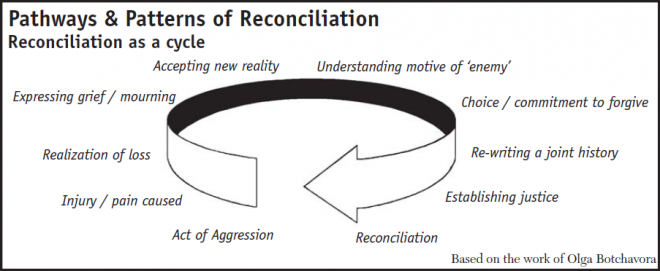
In the marketplace of ideas, the concepts and language of reconciliation have become quite popularized and at the same time diluted. Coming out of the turmoil of the South African political transition of the 1990s, it became abundantly clear to me that the term reconciliation was easily hijacked to serve the particular interests of any number of sociopolitical groupings.
For some, reconciliation was used to describe the political process of power-sharing. For others it referred to new political and legal democratic reforms that allowed former enemies to live together without killing each other. Still others would have used the term to describe a “good working relationship” with persons of another culture or race. While all of these notions have linkages to genuine reconciliation, they are only parts of the whole.
Authentic reconciliation requires us to move beyond mere social tolerance or political coexistence. It is concerned with repairing harmony in the life of a community or nation. By harmony, I mean the restoring of meaningful relationships—relationships of dignity, trust and collaboration. Harmony also infers a collective concern for the common good and a shared future view that gives hope and motivation to the idea of unity.1

Tools for Agents of Reconciliation
There are volumes of published literature on what reconciliation is and how it is accomplished. (See figure above.) Drawing from this brief overview, there are at least six critical elements that need to be considered by those who wish to be agents of reconciliation at either an individual or collective level. With each element there are corresponding skill-sets that can be developed.
- Psycho-social Support and Trauma Healing: Violence causes disempowerment and disconnectedness; reconciliation aims at the exact opposite—empowerment and connection.2
Skills: Trauma awareness, education, debriefi ng and counseling skills - Personal and Public Grieving or “Lament”: The wronged and wrong-doer need a safe space to tell their story and a public space where society “bears witness” to the harm that has been caused.3
Skills: Trauma awareness, education, debriefi ng and counseling skills - Awakening Emphatic Responses: The human brain is biologically “hard-wired” to make human connections and to build community through social networks.4
Skills: Active listening, paraphrasing, summarizing, nonviolent communication and basic counseling skills - Facilitating Forgiveness Transactions: “An act of forgiveness must be understood as a complex process of unlocking painful bondage of mutual liberation. While the perpetrators must be set free from their guilt—and its devastating consequences—the victims must be liberated from their hurt—and its destructive implications.”5
Skills: Active listening, paraphrasing, summarizing, nonviolent communication and basic counseling skills - Re-writing Historical Narratives: Learning how to “remember rightly in a violent world”6 entails dealing with the nationalpatriotic narratives, the historical memories, the lived experience and the current events.7
Skills: Group facilitation, negotiation, mediation, appreciative inquiry, sustained dialogue skills - Engaging in Reparative/ Restorative Justice: Asks what harms have been committed, what needs have been generated, and who is obligated to make things right.8
Skills: Victim-Offender mediation, Family Group conferencing, circle processes
In sum, the end-goal of reconciliation is like a horizon on the landscape; it provides us with the vision, inspiration and moral guidance on what harmonized relations could look and feel like. On the other hand, the skill-sets attached to conflict management, resolution and/or peacebuilding provide us with the necessary instruments or tools — the means — to arrive at reconciliation.
EndNotes
- Catholic Social Thought provides a foundational guiding light in terms of defi ning the values, actions and ethics that should drive this kind of thinking and living.
- Herman, J. Trauma and Recovery – The aftermath of violence from domestic abuse to political terror.
- Katongole, E., & Wilson-Hartgrove, J. Mirror to the Church: Resurrecting Faith after Genocide in Rwanda.
- Early, C. & M. “Neuroscience of Emotion”
- Muller-Fahrenholz, G. The Art of Forgiveness.
- Volf, M. The End of Memory – Remembering Rightly in a Violent World.
- Lederach, J.P. The Moral Imagination – The Art and Soul of Building Peace.
- Zehr, H. Changing Lenses.
[Carl Stauffer, PhD, MA ’02, is Assistant Professor of Development & Justice Studies at Eastern Mennonite University’s Center for Justice and Peacebuilding. This piece originally appeared in the Fall 2011 issue of A Matter of Spirit, a publication of the Intercommunity Peace & Justice Center, and is re-printed with permission.]

I do agree that both wronged and oppressors (if that is the correct word) require a safe space in which to confess or express their hurt. In South Africa, The Truth and Reconciliation Commission has well fulfilled that role, and it is encouraging to watch the further maturation of the Rainbow Nation in the vigorous pursuit of corrupt officials and the disciplining of the former president of the ANC Youth League.